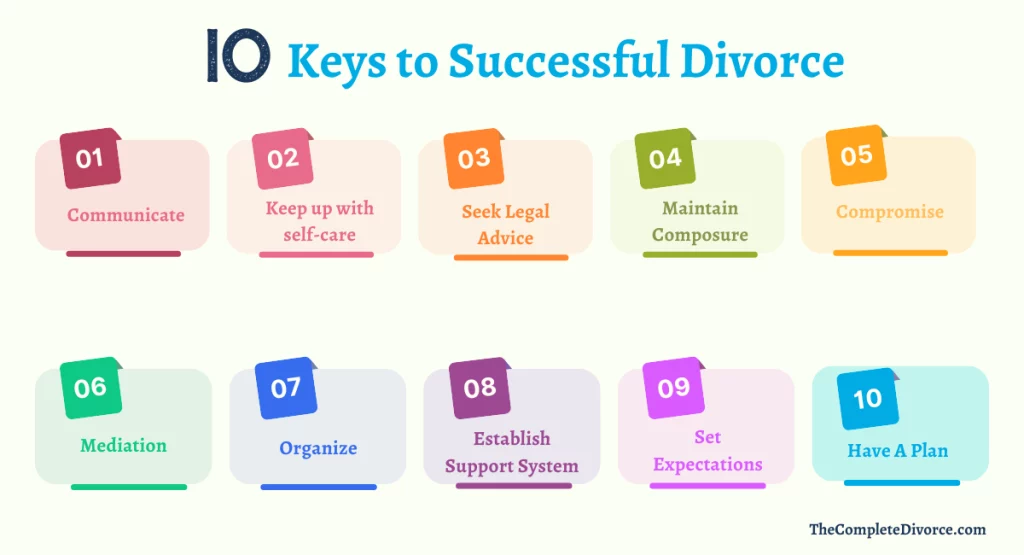
Share
Submitting the Judgment Packet to Finish Your Divorce in California

Dina Haddad
Founder & Attorney Mediator
I’m Dina Haddad, a family law attorney-mediator in California. I’m so tired of couples not having a process that’s easy to complete their divorce. They are getting lost, wasting time and money, and beyond frustrated with their results.That’s why I created TheCompleteDivorce. I took my successful mediation practice and condensed it into an affordable and winning program.

Share
In this guide, We’ll walk you through the essential steps to finalize your divorce in California by creating a divorce judgment. This judgment, also known as a Marital Settlement Agreement, is a crucial document that formalizes the dissolution of your marriage and outlines key aspects of your separation. Let’s dive into the process and ensure you meet all the legal requirements without missing any important details.
Once you have completed the Judgment Packet, make two copies of all documents in your Packet. The original for the court, one for you, and one for your spouse. Provide a self-addressed stamped envelope with enough postage and space for the copies and the original to come back, in case your packet gets rejected. If you are filing an uncontested case, include a check for any unpaid fees for the Respondent’s first appearance with the Judgment Packet. If you are submitting a default, you’ll need to include an additional envelope for the clerk to mail a copy of the Judgment Packet back to your spouse as well.
- Submission Process: Send your Judgment Packet to the family court clerk for filing. You can do this either by mail or by dropping it off at the clerk’s office.
- Processing Time: Unlike some other court filings, the Judgment Packet won’t be processed immediately. The review period depends on the court’s workload at that time.
- Variable Wait Times: The waiting period can vary widely, ranging from a few weeks to several months. The specific duration depends on how busy the family court is.
- Inquire About Review Times: To get an estimate of current review times, consider contacting a family court clerk in your county. They can provide you with more precise information.
- Review Order: Typically, Packets are reviewed in the order they are received, following a first-come, first-served approach.
- Priority Consideration: In certain situations, depending on your county and the clerk’s discretion, you may be able to request priority processing for time-sensitive matters. This can be particularly useful for issues like home refinancing.

Submission and Review of Your Judgment Packet
When received, your Judgment Packet will be assigned to a judgment review clerk, often associated with your assigned department. The judgment clerk will review your Packet to make sure all issues are addressed and the forms are completed correctly. If done correctly, your Packet will be filed finishing your divorce.
If your Judgment Packet is rejected, the entire packet, with copies, will come back to you in the envelope you provided. Most counties have a “Rejection” form that is sent back with a rejected Packet. The form will tell you what you need to fix to have your Judgment filed. If you can, request or locate your county’s rejection letter before you submit your Packet, so you can use the Rejection letter to check your work and make sure you are submitting everything correctly.
Completing your Judgment Packet and getting it approved gets you through the finish line. So take time to make sure you have completed the agreement and JC forms correctly. Check with your county clerk or local rules to make sure you completed any county requirements. This could be an additional form or the requirement that you not use staples, or that originals be two-hole punched and larger documents fastened with a fastener. If possible, hire a divorce professional to review your Judgment Packet. The one or two hours of their time will be well worth it.
If you make a mistake and your Judgment Packet is rejected, you’ll have to resubmit it. When you submit your Packet again, you’ll go back to the end of the line and have to wait for the review. This can be frustrating and can add several more months to your divorce. However, at this point, you are near the end. Your signed written agreement is still enforceable, and it’s a matter of perfecting your Packet so that it’s filed. Once your Judgment Packet is filed, you are officially done with your divorce.
At TheCompleteDivorce, we provide you with what you need to successfully do your California divorce on your own. We provide all the required family law court forms in our automated forms program, all the video tutorials, and an automated customizable Marital Settlement Agreement (Divorce Agreement). If you need more help, you can get our package which includes time with a divorce mediator.
Before you go, consider if we can help you. We have helped thousands of couples in California. Our guided DIY divorce is successful and super affordable! Book a free consultation now. Our services are all 5-star!
FREQUENTLY ASKED QUESTIONS
What is a "Default Judgment Packet" in a California divorce, and when is it used?
A “Default Judgment Packet” in California is used when one party in a divorce fails to respond or appear in court. It allows the other party to proceed with the divorce. You can find the packet on your county’s court website or at the courthouse and follow the provided instructions.
How can I get a "Notice of Entry of Judgment" for my divorce in California?
A “Notice of Entry of Judgement” is normally prepared by the prevailing party or their attorney. After the judge signs the judgment, the prevailing party must serve the notice on the opposing party. Check with your attorney or the court clerk for clarification on court rules.
What is the process for requesting a default judgment in a California divorce case?
To request a default judgment in a California divorce case, you must fill out and file all the required paperwork, including the “Request for Default Judgment“. Make certain you follow the processes stated by your county’s family court.
How much usually it takes time for a judge to sign a divorce decree in California?
- In California, the time for a judge to sign a divorce decree varies.
- It depends on factors like the court’s caseload and case complexity.
- The duration can range from several weeks to several months.
- You can inquire about the estimated timeframe from your local court.






